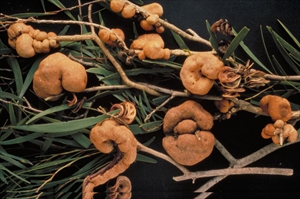Acacia rust
Pacific Pests, Pathogens and Weeds - Online edition
Pacific Pests, Pathogens & Weeds
Acacia rust (235)
Uromycladium tepperianum. There are several species in this genus. Depending on the species, they may be limited to a single host, or to several hosts which are closely related.
Recorded from Australia, Indonesia, New Caledonia, New Zealand, Papua New Guinea, and South Africa. It is not recorded in Fiji, Samoa, Solomon Islands, and Tonga.
Species of Acacia, and other genera in the Fabaceae.
Uromycladium tepperianum is a rust fungus that infects more than 100 species of Acacia and several other genera in the plant family Fabaceae. The rust produces chemicals that cause trees to produce large conspicuous galls (Photos 1&2). The shape and size of the galls, as well as the part attacked varies depending on the host species. The galls are hard, irregular, up to 150 mm across, and weigh up to 1.5 kg. On some species, the chemicals also cause masses of shoots, termed witches' brooms, to grow from the stems.
The galls are formed on the 'leaves' (they are leaf-like petioles), and the seedpods. They are light brown when young and spore producing, becoming dull-brown with age.
Rusts often have several spore stages, and sometimes two hosts. This rust is different. It has only two types of spores: 'pycniospores' and 'teliospores', and they are formed on the same host. The pycniospores are a form of mating spore, and are produced in structures called 'pycnia'. Mating occurs when spores of one pycnia fuse ('mate') with the fungal threads (called 'hyphae') of another.
The teliospores form a brown layer over the galls, especially during the rainy season. The spores which make up this layer have thick walls allowing them to withstand drying from sun and wind as they disperse in the air. Spread by insects coming into contact with the spores is a possibility for short distance spread.
In severe attacks, the trees may be full of galls, and weakened by the reduced leaf canopy. Seed production may be affected. The fungus does not kill its tree host directly, but causes it to become more susceptible to drought stress.
Acacia pycnantha, cultivated in Australia for its bark, is severely affected by Uromycladium tepperianum, which causes significant yield losses and eventually death. However, this rust has potential as a biocontrol agent for acacias that have become weeds outside of Australia. For example, Uromycladium tepperianum is highly effective against Acacia saligna in South Africa, and it is also being considered against Paraserianthes lophantha subsp. lophantha (Cape Wattle) which is another weedy species in that country.
Look for the characteristic hard brown galls, up to 150 mm across. Look for the dry brown powdery spores that are produced in large amounts on the galls in the rainy season.
BIOSECURITY
Even though Uromycladium tepperianum is spread by wind, and spores may be transported long distances, it's unlikely that natural transfer will occur unless the host species are planted outside their natural range. For example, the spread of Uromycladium species to New Zealand, Malaysia and the Philippines is thought to have occurred by wind after the planting of susceptible species were introduced. Therefore, quarantine considerations are needed only where hosts have been planted outside their natural range and are of economic value.
CONTROL
There is no treatment for this disease, except to replace the susceptible trees with (similar) species which are not hosts.
AUTHOR Grahame Jackson
Information from Encyclopedia of Life (undated) Uromycladium tepperianum (Sacc.) McAlpine. (https://bie.ala.org.au/species/1b8cab79-5baf-4041-89ce-b4041818908e); and Systematic Mycology and Microbiology Laboratory, ARS, USDA. (2007). Invasive Fungi. Uromycladium tepperianum on Acacia spp. (https://nt.ars-grin.gov/taxadescriptions/factsheets/index.cfm?thisapp=Uromycladiumtepperianum); and Uromycladium tepperianum (Sacc.) MacAlpine (2008) Pathogen of the month. APPS. (https://www.appsnet.org/Publications/potm/pdf/Jan08.pdf); and from CABI (2020) Uromycladium spp. that cause gall rusts (Acacia gall rusts). Crop Protection Compendium. (https://www.cabi.org/cpc/datasheet/55738). Photos 1&2 Kohler F, et al. (1997) Diseases of cultivated crops in Pacific Island countries. South Pacific Commission. Pirie Printers Pty Limited, Canberra, Australia.
Produced with support from the Australian Centre for International Agricultural Research under project PC/2010/090: Strengthening integrated crop management research in the Pacific Islands in support of sustainable intensification of high-value crop production, implemented by the University of Queensland and the Secretariat of the Pacific Community.





